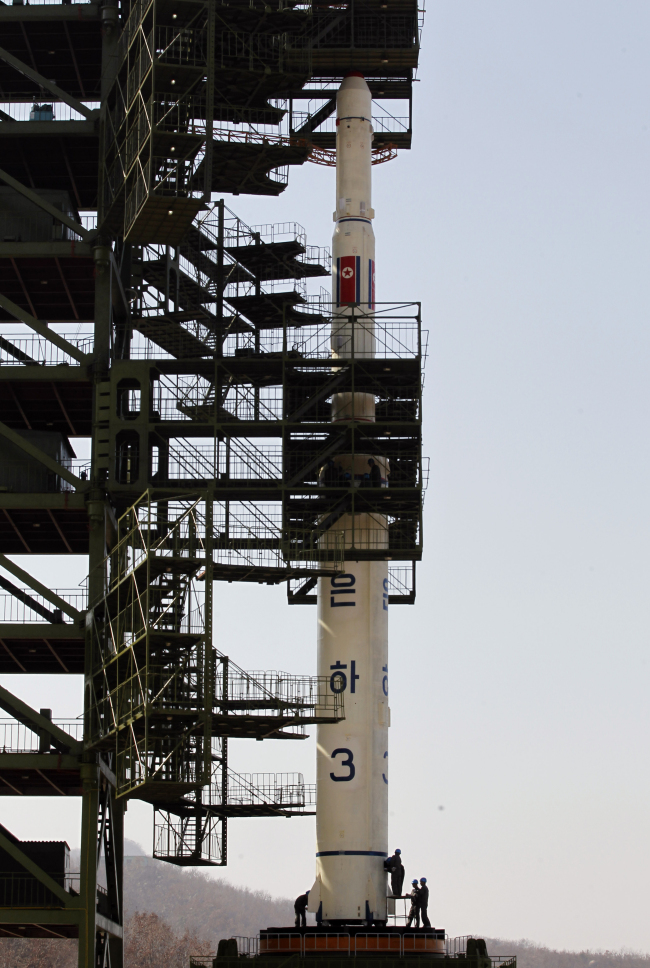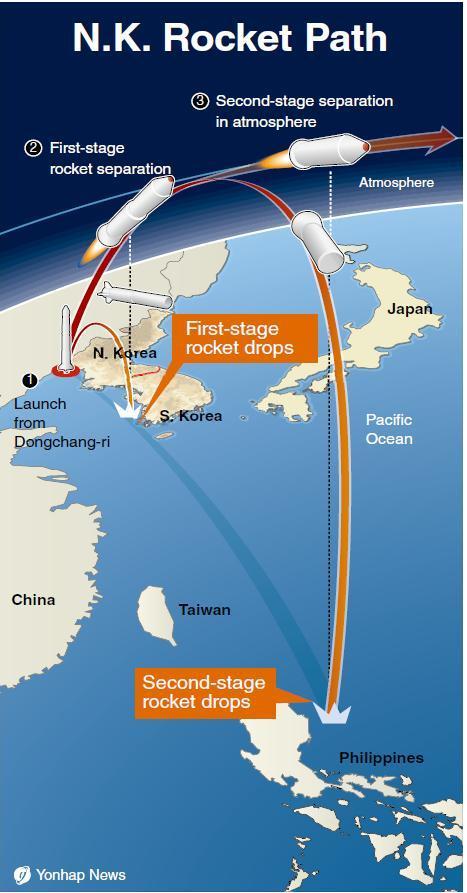N.K. launches long-range rocket
Washington confirms satellite in orbit; Seoul says Pyongyang must take full responsibility
By 윤민식Published : Dec. 12, 2012 - 10:23
North Korea successfully launched its long-range rocket on Wednesday, indicating major progress in its capability to deliver nuclear weapons as far as the mainland United States.
The provocation prompted condemnations from the international community including South Korea, the U.S., Japan and the European Union. China, its traditional ally, expressed regret.

The Unha-3 rocket blasted off from the Dongchang-ri site in the North‘s northwest at 9:49 a.m., officials said. Its first stage fell into the Yellow Sea off South Korea’s west coast, and the second stage landed in waters near the Philippines, they said.
North Korea claimed that it successfully fired the rocket and put its satellite into orbit.
“The second version of satellite Kwangmyongsong-3 successfully lifted off from Sohae Space Center by carrier rocket Unha-3 on Wednesday,” the official Korean Central News Agency said. “The satellite entered its preset orbit.”
The success will pose a serious threat to security in Northeast Asia and the U.S. as North Korea has apparently gained the long-range firing capability to reach the U.S. mainland, analysts said. Experts have warned the Unha-3 rocket is believed to have a range of some 10,000 kilometers.
North Korea’s long-range rocket launch marks the second this year, following the test-fire of a rocket in April.
The launch came a week before North Korea marks the first anniversary of the death of late leader Kim Jong-il, father of current leader Kim Jong-un. It also came ahead of South Korea‘s Dec. 19 presidential election, spurring speculation that Pyongyang is attempting to sway the tight race for Seoul’s top office.
“The missile’s loaded object has apparently entered into orbit. But we still have to see whether it will operate properly,” Kim Min-seok, spokesperson for the Defense Ministry, told the press.
“We believe that the North fired the missile to show that the Kim Jong-un regime is in firm control and stable.”
The North American Aerospace Defense Command earlier commented on the launch.
“Initial indications are that the (North Korean) missile deployed an object that appeared to achieve orbit. At no time was the missile or the resultant debris a threat to North America,” the North American Aerospace Defense Command said in a statement.
North Korea has claimed the planned launch was aimed at putting a satellite into orbit.
But South Korea, the United States, China and other countries have denounced it as a disguised ballistic missile test and a violation of U.N. Security Council resolutions that ban Pyongyang from any ballistic activity because it can be used to develop missiles capable of carrying nuclear weapons.
South Korea said it “strongly condemns” the firing as a violation of U.N. Security Council resolutions while warning that the communist nation will have to “take full responsibility” for the violation and face deeper isolation from the international community.
“North Korea‘s launch this time will only result in the deepening of its isolation from the international community,” Foreign Minister Kim Sung-hwan said, reading a government statement issued after an emergency National Security Council meeting.
“The government yet again urges North Korea to divert the enormous financial resources wasted on the development of nuclear weapons and missiles to addressing the pressing issue of taking care of the everyday lives of its citizens,” Kim said.
The launch was widely unexpected by the international community as intelligence sources had indicated that it may be disassembling its rocket to fix technical problems.
North Korea recently announced that it was extending the launch window to Dec. 29, from Dec. 22. Analysts expected that it would take about a week to restage its three-stage rocket and fire around Dec. 17 ahead of South Korea’s presidential election.
Seoul’s Defense Ministry said that the radar systems of its naval destroyers detected the rocket launch from 9:51 to 9:58 a.m.
“Our Sejong the Great Class destroyer deployed in the West Sea first detected North Korea’s long-range missile at 9:51 and 20 seconds,” Kim said.
Its fleet of Aegis destroyers continued to track the missile, whose first stage separated at 9:52, then captured it rocketing over the sky of Baengnyeong Island at 9:53.
Its radar followed the missile until it passed over Japan’s Okinawa at 9:58.

The ministry spokesperson said it was out of its “ability” to track the missile after 9:58 when it flew out of South Korea’s territory, and that it had to consult with its U.S. ally for further information.
The ministry added that it will not disclose the activity of its search for the rocket debris that fell in its territory.
“We are maintaining our Watchcon (2) and raised the Jindotgae alert to 2,” Kim said. Jindotgae is an alert raised when South Korea expects threats from the North.
South Korea’s defense officials have been calling North Korea’s rocket a missile as they are technologically the same, simply carrying a different payload. They claim the launch is likely a cover for an intercontinental ballistic missile test. Analysts said it has the capability to target as far as Los Angeles in the U.S.
The Defense Ministry said that it has monitored and sensed North Korea preparing the launch since Tuesday from its Joint Chiefs of Staff’s command center as the media and opposition political parties highlighted “security holes” in the armed forces’ intelligence system.
The ministry emphasized that it had never verified any news reports that North Korea was moving to disassemble its rocket to fix technical problems, and reiterated that it detected North Korea getting ready for launch on Tuesday.
It was expected that North Korea would fire the rocket around Dec. 17 aimed in part at tipping South Korea’s presidential election in its favor, as well as to mark the first anniversary of death of Kim Jong-il. Some suggested that it might even delay the launch to spring of next year.
Analysts speculated that the North may have pushed forward the launch on Wednesday due to favorable weather conditions. The North’s Dongchang-ri launch site had clear skies with a temperature of around minus 8 degrees Celsius.
“Weather is an important factor for rocket launches as it could affect its electronic and control systems,” said Chang Young-keun, a rocket science expert at Korea Aerospace University.
Chang also noted that experience in rocket launching is another important factor, adding that North Korea far exceeds the South in this area including long-range liquid-fuel rocket technology development.
By Park Hyong-ki and news reports
(hkp@heraldcorp.com)






![[From the Scene] Monks, Buddhists hail return of remains of Buddhas](http://res.heraldm.com/phpwas/restmb_idxmake.php?idx=644&simg=/content/image/2024/04/19/20240419050617_0.jpg&u=20240419175937)





![[Graphic News] French bulldog most popular breed in US, Maltese most popular in Korea](http://res.heraldm.com/phpwas/restmb_idxmake.php?idx=644&simg=/content/image/2024/04/18/20240418050864_0.gif&u=)


![[From the Scene] Monks, Buddhists hail return of remains of Buddhas](http://res.heraldm.com/phpwas/restmb_idxmake.php?idx=652&simg=/content/image/2024/04/19/20240419050617_0.jpg&u=20240419175937)

![[KH Explains] Hyundai's full hybrid edge to pay off amid slow transition to pure EVs](http://res.heraldm.com/phpwas/restmb_idxmake.php?idx=652&simg=/content/image/2024/04/18/20240418050645_0.jpg&u=20240419100350)

![[Today’s K-pop] Illit drops debut single remix](http://res.heraldm.com/phpwas/restmb_idxmake.php?idx=642&simg=/content/image/2024/04/19/20240419050612_0.jpg&u=)